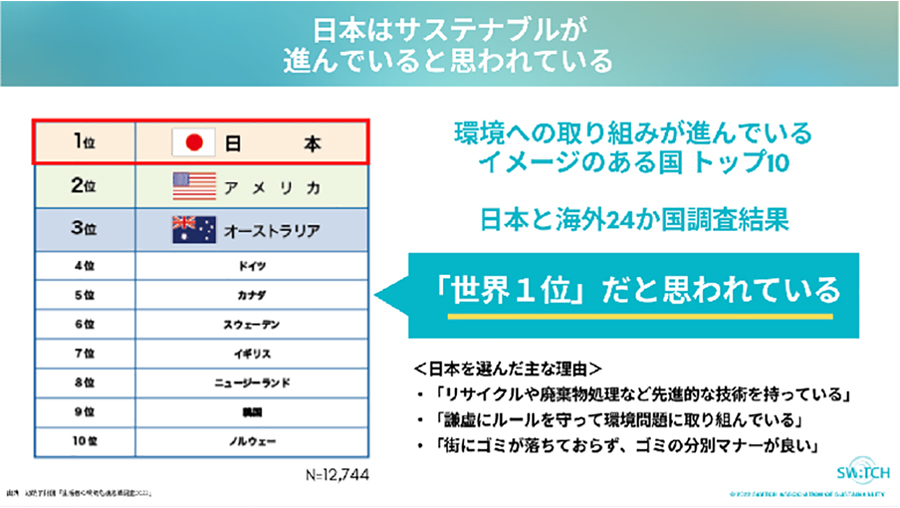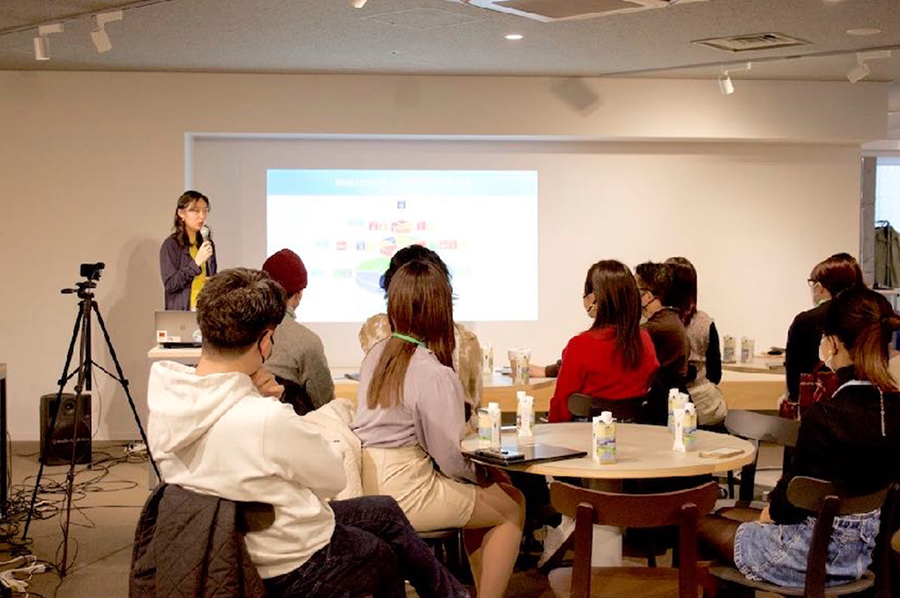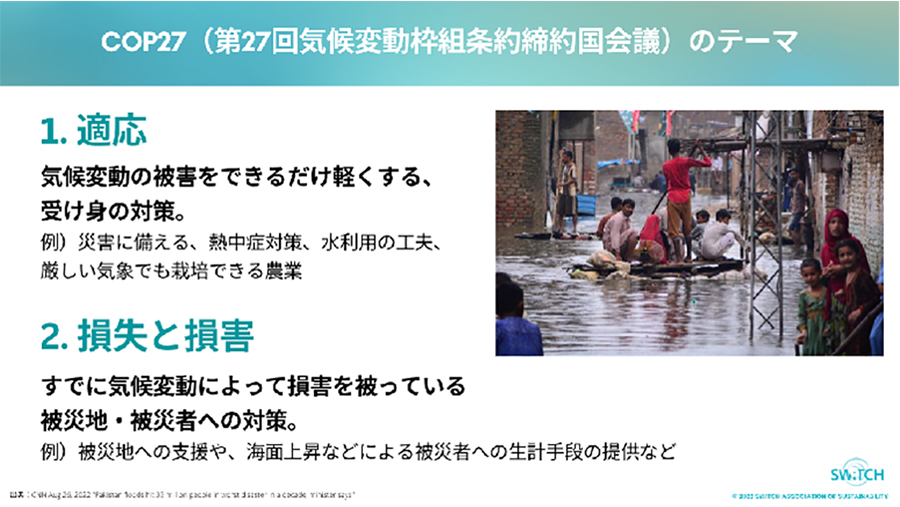
地球の気候変動や温暖化対策を話し合う国際会議「COP(Conference of the parties=気候変動枠組条約締結国会議)」。現在、我々が日々耳にする脱炭素、カーボンニュートラル、温室効果ガス、地球温暖化などのキーワードについて、この「COP」で決められた方針が各国の方針に大きな影響を与える重要な役割を果たしています。
このような問題に対して、Z世代と企業、双方が共に当事者意識を持ち、アクションを起こしていくための勉強会「渋谷COPアカデミー」。その第2回目の模様をレポートします。

前回と比較すると参加メンバーも増え、特に企業でサステナブルや脱炭素に取り組んでいる当事者の参加も目立ち、輪が広がっているのを実感できた第2回目の「渋谷COPアカデミー」。
おさらいも兼ねて、一般社団法人SWiTCH代表理事・佐座槙苗さんによる気候変動問題の現在地についてのインプットからスタートします。

「『環境への取り組みが進んでいるイメージがある国』を日本と海外24カ国でアンケートをとった結果、日本は世界1位という結果が出ています。皆さんはどのように思いますか?
残念ながら、現状は違います。2015年から2021年で気候変動に関心がある人の割合は、 ドイツ・イギリス・オーストラリア.・韓国・スペインが10%以上上がっているのに対し、日本だけが8%下がっています。


また気候変動問題に対する意識は先進国13カ国中最下位で、テレビ・新聞/SNS・日常会話で週に一度以上、気候変動の話を聞く人の割合は、先進国の多くが週60回前後なのに、日本は途上国と同じ週30回未満という結果が出ています」(佐座さん)
佐座さんは、日本がまだまだ気候変動・環境問題で遅れている現状を最初に指摘します。そして、環境問題の影響を直接受けるのは若いZ世代であること、情報や流行の発信地であり、多様性のある街・渋谷がサステナブルな街のモデルケースになる価値を説明し、そのきっかけを生むことこそが「渋谷COP」の意義だと語ります。

またSDGsで掲げられている17の目標のなかでも、生態系・環境の保護こそが最重要であることをウェディングケーキにたとえて説明します。
「ウェディングケーキは土台がしっかりしていないと成り立ちません。上から順に、経済、社会、生態系の目標があり、すべてのベースとなる生態系をしっかり保全していかなくては、社会と経済が成り立たない。まずは生態系や環境を守ることが最重要です」
参加者が当事者意識を持てるよう、わかりやすく身近な例を用いて説明する佐座さん。つづけて、地球の現状についてこのように話します。


「世界中の人が日本人と同じ生活をしていると、地球がいくつ必要でしょうか? 答えは2.9個分です。地球はひとつしかないのでこれは持続可能ではありません。地球にはプラネタリーバウンダリーと呼ばれる容量があり、『生物圏の一体性』『土地利用変化』『生物地球科学的循環』はすでに限界値を超えていると言われています。環境は繋がり合っているため生態系の損失、熱波、森林火災、感染症、海面上昇、食糧不足、水不足、強い台風、洪水など災害がドミノ倒しのように連鎖して起きています」
さらに佐座さんは「2050年までに世界で何割の地下水がなくなる?」と参加者に問いを投げます。こちらの答えは「7割」。水資源がなくなることで、さまざまな争いが起きることは容易に想像がつきます。佐座さんが説明したのは、ごく一部の地球の現状ですが、すでに「待ったなし」であることを参加者は痛感しているようでした。

そして、次に世界は環境問題に対してどういうアクションを起こしているのか?に話題は移ります。トピックは「Future Earth(持続可能な社会への転換をめざす、国際的研究プラットフォーム)」が掲げる『10 New insights』について。前回の「渋谷COPアカデミー」では、そのなかから1~3の項目が紹介されましたが、今回は4~6の項目について触れられました。

【10 New Insights】
- 適応は無限という神話を疑う
- 脆弱性のホットスポットは「リスクのある地域」に集中する
- 気候と健康の相互作用により新たな脅威が出現した
- 気候変動による人口移動に対しては、現在の根拠に基づく以上に先見的な行動が求められる
- 人間の安全保障には、気候安全保障が必須である
- 持続可能な土地利用は気候目標達成に不可欠である
- 民間のサステナブルファイナンスの実践は、まだ本格的な社会変遷を引き起こすには至っていない
- 損失と損害への対策が今、地球規模で緊急に求められている
- 気候変動にレジリエントな開発に向けた包摂的な意思決定が必要である
- 構造的な障壁と持続不可能なロックインの打破が必要である
(参照:「Future Earth 日本委員会」より)
「4は、気候変動によって移住が増加し都市部に人口が集中する問題です。世界銀行によると、2050年までに2億人以上が気候変動により移住すると言われており、紛争などよりも、洪水や台風といった天災による人口移動が多くなるとされています。

5の『人間の安全は気候変動対策に依存している』は——水の枯渇の問題にも触れましたが——気候変動が地球のサプライチェーンに大きな影響を及ぼし、食料やエネルギーの問題に直結し、紛争につながる危険性を示しています。

6は、サステナブルな土地利用。つまり気候変動にともない最適な供給を維持するためにはどうすればいいのか?と、土地利用について考え直す必要があります。たとえば、単一栽培から環境再生型農業へ移行し、土壌を修復・回復しながら土地を利用するといったことなどが考えられています」

「2030年の関連市場は42兆円と予測されており、防災や農業技術の分野で日本企業が途上国に提案できる機会も増えると言われています。日本は災害大国で、これまでにさまざまな災害対策のプログラムを生み出してきました。早期警戒システムの導入、損害保険制度、損害観測・予報、人材育成、適応ビジネスなどすべて世界的にみても先進的な事例です。日本が世界にこのようなプログラムを輸出することで、気候変動問題に貢献することが可能です」


その後は、留学経験のある学生スピーカーにバトンタッチし、それぞれスペイン、スウェーデン、オランダなどヨーロッパ諸国のサステナブルなライフスタイルを紹介、グループワーク、発表が行われました。質疑応答も活発で、初回より「サステナブルな街・渋谷」の輪が確実に大きくなっていることを感じることができました。

学生、企業、行政と気候変動に関心のある多様な方たちが学び、意見交換をし、ネットワークがつくられている「渋谷COPアカデミー」。今後どのようなアクションにつながっていくのか、さらに期待が高まる内容となりました。

